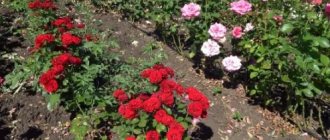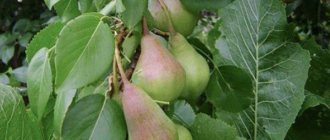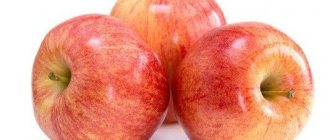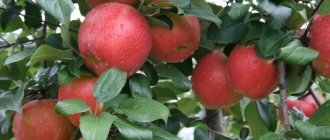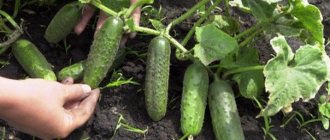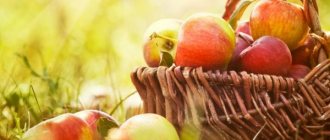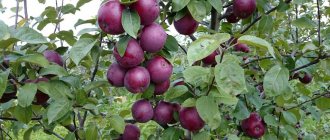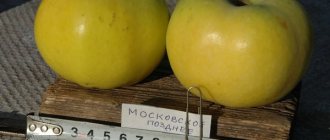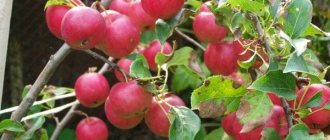The winter hardiness of apple trees is a combination of several characteristics of the tree and its root system. This allows apple trees to comply with the climatic conditions of a particular region. Winter-hardy apple trees must withstand severe frosts at the beginning of winter, withstand persistent and prolonged frosts of the winter period and a sharp drop in temperature after the spring thaw. Winter hardiness is formed in the process of long-term selection work. In some varieties of apple trees, this factor is hereditary. Often the winter hardiness of a variety is the reason for some deterioration in the taste characteristics of the fruit.
Summer varieties
Summer varieties ripen earlier than others - the first fruits begin to be picked at the end of July. Such varieties are especially appropriate in regions with short, cool summers - they have time to ripen before the onset of cold weather. The fruits of summer varieties are ready for consumption immediately after being picked from the tree.
Ermakovskoe mountain
A summer variety bred by Siberian breeders back in 1965. The plants are low, with rounded crowns. They bear fruit in 4-5 years. Apples are harvested in mid to late August. Frost resistance is normal. It bears fruit with indistinct periodicity. You can collect from 8.8 to 14 tons from 1 hectare. From 1 tree - up to 35 kg of apples.
The fruits are round, light yellow, with red streaks on the sides. Weigh 70-80 g. Sweet and sour, with a pleasant apple aroma. They are stored for no longer than a month. Satisfactory resistance to scab. This variety is “average” in all respects. It attracts gardeners with its early ripening and relatively large fruits. For Siberia, 80 g are quite large apples.
Altai crimson
Autumn small-fruited variety of Siberian selection. Introduced in 1963. Tree of medium height with a wide oval crown. Stable fruiting - from 4 years. The harvest ripens at the end of August. Productivity from 11 to 19 t/ha. The average harvest is 35 kg of apples.
The fruits are yellowish, with a red outer color and a rich blue bloom. Weight – 25-30 g. Shape – round-conical. The flesh is creamy in color, with red veins. The taste is sweet and sour. Shelf life – 60 days. Advantages: winter hardiness, early fruiting, immunity to diseases, including scab. A universal variety that is valuable for private owners and large agricultural producers.
Alyonushka
Summer dwarf apple tree is the best hybrid for the forest-steppe zone of Siberia. Bred by Krasnoyarsk breeders in the 60s. One of the fastest growing and most delicious varieties. The variety is extremely popular - its seedlings are grown en masse at experimental stations. Ripening - mid-August. Bears fruit in the 3-4th year. Maximum fees – 80 kg per tree.
The fruits are medium-sized, weighing 30-40 g. Round or flattened apples become light yellow when ripe. Over the entire surface there is a tan in the form of red-pink shading and spots. The smooth skin has a waxy coating. Shelf life – up to 6 weeks. Very winter-hardy variety and high ability to revive.
Minusinsk red
Summer variety from the Minusinsk OS, created in the 70s. last century. Medium-sized trees with a spreading crown grow up to 3 m in height. Ripening – second half of August. Harvesting – 14-25 t/ha, per tree – 21 kg.
The apples are round, golden, with a diffuse brick-red coloring. There are multiple subcutaneous dots on the skin. Weight – 22-32 g. The taste is sweet, the aroma is of medium intensity. The litter can withstand temperatures of minus 42°C. The variety is fast-growing and bears fruit abundantly every year. Disadvantage: low resistance to scab. There are seasons when apples are bitter. Processing is limited to juice production.
Zhebrovskoe
Summer apple tree, bred by Siberian breeders in 1959. The earliest variety in Siberia. The tree is medium-sized. The fruits appear in the 4th year. 16-17 kg of apples are harvested from one tree, 9 tons from 1 hectare.
Small-fruited variety. Fruit weight is 25-35 g. Round-conical fruits are light yellow in color, with a dark purple outer color. The surface is waxy. The taste is sweet and sour. The fruits do not spoil for 2 weeks. The variety is winter-hardy and resistant to scab and other infections.
Gornoaltaiskoe
Mid-summer variety. Semi-cultural. An old variety of Siberian selection. A plant with a rounded crown, height – 3.5 m. Picking apples from a tree – 35 kg. Maximum collection – 100 kg. It bears fruit in 4-5 years. Fruiting lasts up to half a century.
Fruit weight - 40 g. Conical, ribbed apples are yellow in color, with a bright red outer color. The fruits have very long thin stalks. During prolonged frosts, freezing is possible. Very resistant to scab. Apple skins crack during the rainy season.
Ranetka Ermolaeva
This is a variety of amateur selection. Named after its creator. Obtained in 1937. The plant is medium-sized with a sparse pyramidal crown. The crop is harvested at the end of August. The tree produces up to 10-11 kg of fruit.
The fruits are very small, weight - 8-12 g. The oval fruits are yellow, the outer color is dark red. The ribbing is weak. The pulp is loose and juicy. Surface with a bluish coating. Ranetka is resistant to drought and frost. Not resistant to scab.
Russian beauty
Summer high-yielding variety. The trees are medium-sized. In the 5th year the first fruits appear. Harvest - annually. Apples are ready at the end of August.
Large, bright raspberry apples - 90-100 g each, look very beautiful. They have juicy, white flesh, pleasant smelling, and tender. When the apples are ripe, their aroma can be felt from afar. Slightly affected by scab. Stored for up to 60 days.
Preparing the apple tree for wintering
Apple trees for the Urals require shelter for the winter. To do this, they are covered with a layer of mulch and fertile soil 10 cm high. The crown of the tree can be covered with spruce branches, dry grass and leaves, or other materials. Plants must be protected from rodents by wrapping the trunks with nylon or setting traps with poisonous bait. The poison must be removed in the spring so that birds do not eat it.
One of the shelter options for a creeping apple tree:
- support all skeletal shoots with supports so that they do not sag from the weight of the material;
- cover the tree with thick fabric, such as burlap;
- cover the edges around the perimeter with earth;
- place a thick layer of insulating material on top of the burlap;
- protect the surface from getting wet with oilcloth;
- secure the frame with boards, sprinkle soil on top.
Trees need whitewashing of the trunk, which is carried out before sheltering for the winter. This will prevent burns from the bright spring sun. You cannot remove the cover too early, otherwise the apple trees will freeze if frost returns. Young trees are very sensitive to sudden temperature changes, so the protection is removed gradually.
Autumn varieties
A distinctive feature of all autumn varieties is good ripening. That is why apples that ripen in the fall have improved taste characteristics.
Northern Sinap
Late variety, partially self-fertile. Up to 150 kg of fruits are collected on one tree. Tall tree with medium dense crown. The fruits ripen in early October.
Fruit weight 120 g. Resistant to frost and disease. The fruits are juicy, sweet and sour, oblong, round-conical. The skin is smooth and becomes oily during storage. The color is yellow-green, with a red-brown outer color. Many light subcutaneous dots. The flesh is white or greenish, the taste is spicy. Apples are stored until May-June.
Lungwort
Summer variety, bred in the 50s. of the past century. The first fruits are in the 4-5th year. There is a cyclicity in the amount of harvest. The fruits ripen at the end of summer. Harvesting - up to 180 kg of fruit.
Lungwort apples, even when unripe, are delicious. Weight - 100-150 g. Flat-round apples are yellow-green in color, the outer color is rich crimson. Pros: winter hardiness, scab resistance. They are stored for no more than a month.
Memory of Zhavoronkov
Autumn variety from Ural breeders. Ready at the end of September. The plant is tall, with a pyramidal spreading crown. The maximum yield is up to 95 kg of apples.
Apples weigh 100-110 g. Greenish-yellow, flat-rounded fruits with a reddish blush. Shelf life – 3 months. The creamy pulp has a good taste. The downside is that during hot weather and dry air, the taste of apples deteriorates and they crumble to the ground. The variety is very winter-hardy.
Anise purple
Late ripening table variety. Obtained by crossing Anis Scarlet and Ranetka Purpurova. Cleaning - end of September. The fruits are stored until mid-winter. An adult tree can produce up to 300 kg per season.
The fruits are round, very attractive, the main color is light green. Cover color is purple. The taste has a winey sweetness. Strong aroma. The skin is rough. As they age, the fruits become smaller. Handles transportation well.
Surkhurai
Medium-sized tree with a small crown. Up to 3.5 m in height. Apples ripen in August and early September. The maximum yield is 55 kg per tree. Fruits - from the 4th year.
The round-flat fruits have a golden-yellow color and a crimson blush. Weight – 60-100 g. They have a sweet and sour taste and a barely pronounced aroma. The color of the pulp is cream. Storage – up to 2 months. It tolerates cold well, is resistant to fungi, and is not afraid of spotting.
Tolunay
Summer apple tree. Compact, with a round crown. Ideal for Siberia. The fruits appear in the 4th year. Productivity from 5 t/ha increases to 29 t/ha.
Apples with slight ribbing. The shape is truncated-conical. Weight 90-110 g. Golden color, red on top. The fruits have juicy, cream-colored flesh. The fruits are sweet and strong-smelling. High frost resistance, shelf life - 2-3 months. Not afraid of scab.
Mountain Sinap
A relatively new late autumn variety of Siberian selection. Medium-sized trees with a wide crown. Fruiting is abundant, without interruptions. Productivity – 15 t/ha. An apple tree produces up to 10 kg in the 3rd year, and 50-60 kg in the 10th year.
The fruits are relatively large - up to 150 g. Greenish-yellow apples, when ripe, become dark pink - acquiring a cover color. The shape is a truncated cone, the ribbing is weakly expressed. The pulp is white, juicy, very tasty. The taste is dessert. Keeping quality is high. The fruits retain commercial quality for six months. The variety is not afraid of scab. Minus - possible freezing.
Altai souvenir
This is an autumn apple tree of Siberian selection. The variety was bred in 1954. Valued for the beauty and taste of the fruit. The trees are medium-sized, the crown is rounded and moderately dense. Apples ripen in early September. The yield is regular - 20-40 kg per tree.
The apples are round, light yellow, quite large - 80-120 g. Cover color - dark pink shading. The creamy pulp has a sweet and sour, pleasant taste. Shelf life – 4 months. Instability to moniliosis.
Bayana
Autumn self-fertile variety. Created in 1984. Apples ripen in early September. Fruits in the 4th year. Tree height – up to 4 m. Harvest from 1 hectare – 14 tons.
The weight of round golden fruits with purple stripes is 90-120 g. The creamy pulp has a rich apple aroma. The taste is excellent. Fruit storage – 4 months. The variety is drought-resistant, not affected by scab, but can suffer from cytosporosis.
White filling
A popular variety grown in Siberia for a long time. A reliable variety, White filling, found among many gardeners in Siberia. The trees are vigorous, with voluminous crowns. The fruits ripen in September. An extremely viable variety, it can grow in different forms, including slate. Collection from a tree – up to 80 kg.
The fruits are medium or large - 100-110 g. Whitish-green, sometimes slightly tanned - on the sunny side. Very juicy, sweet and sour pulp. High recovery ability. The downside is that the apples are not one-dimensional, fruiting is cyclical, they are affected by scab, and the apples fall off when ripe.
Ural liquid
This autumn variety was bred by Chelyabinsk breeders based on the famous Papirovka. The variety is old, bred in the 40s. last century. They classify it as semi-cultured. The trees are medium-sized. The fruits ripen by mid-September. The harvest of Ural bulk apples is carried out in three stages. The first harvest is used for compotes and juice, the second is eaten fresh, the third is used for jams and marmalade. The harvest from a tree reaches 250 kg. From 1 ha – 20 tons.
The fruits are small, round, greenish-yellow, with small subcutaneous dots. Weight – 50-60 g. The fruits are sweet, the flesh is yellowish, very juicy and tender, with a pleasant apple aroma. Apples do not fall off, even when they begin to overripe. Storage duration is 1.5-2 months. Extremely high winter hardiness.
Ural bulk has exceptional winter hardiness - a case was recorded when, at minus 57 degrees, trees of this variety only froze a little, and soon quickly recovered.
Landing
When choosing apple tree varieties suitable for Siberia and determining planting dates, you need to take into account the characteristics of these regions: long winters, too close groundwater, as well as a short growing season for plants.
The ideal time for planting seedlings in Siberia is spring.
There are no specific calendar days for planting apple trees in the spring, since the winter can be long, in which case you need to wait until it warms up and the snow melts. Gardening activities can begin as soon as the ground becomes soft. Early planting has its advantages: the seedling's growing season and time for adaptation are increased.
Selecting a site for planting
The ideal place for growing Siberian apple trees would be a site on the south side, located on an inclined surface, which will prevent stagnation of moisture and rotting of the root system.
Basic requirements for the place where apple trees will be planted:
- good sunlight exposure;
- location that excludes the penetration of gusty winds;
- saturation of the soil with nutrients necessary for life.
If there are no conditions favorable for growing apple trees in a particular area, you can provide the trees with everything they need on your own: add fertilizer to the soil, build a fence from the wind, and protect them from groundwater using drainage.
If the groundwater level is high in the area, you can use a food-grade heating cable .
Preparation for transplanting seedlings
Growing an apple tree from seeds is a long process and low yield. Therefore, seedlings suitable for harsh regions are purchased for planting. It is best if their age varies from 1 to 3 years. It is advisable to purchase zoned varieties with a completely closed root system. If planting is planned on a small area of land, then preference should be given to columnar varieties.
It is recommended to plant seedlings in the spring, this will allow them time to adapt and get stronger before the onset of cold weather.
Before planting, the roots of the seedlings should be placed in a mixture with diluted rootstock for a day. The right time for spring events is from the second half of April to mid-May. The interval between planted trees should be at least 4 m.
Preparing a hole for planting an apple tree
For spring planting of apple trees, holes are dug 2-3 months in advance. It is advisable to prepare not only the hole, but also the soil around it, since the root system absorbs the substances necessary for growth from the entire area of the site. In some varieties of apple trees, the roots grow up to 12 m wide. You can get a good harvest from these trees only on fertile lands with neutral characteristics.
Before digging the soil, you need to moisten it a little.
It must be taken into account that the distance of the root system from groundwater must be at least 2 m, otherwise the roots will rot. If the groundwater lies higher, you must first make an embankment (with a height of 1 to 1.5 m), and only then dig a hole. Standard pit depth varies from 1 to 1.2 m in diameter and from 0.4 to 0.6 m in depth.
Clay soil
When planting a seedling in clay, the hole must be prepared with a large width and shallow depth; in a sandy area it must be slightly narrowed and deepened.
Since heavy clay soil contains few useful substances and does not drain water well, a year before planting apple trees it must be supplemented with several components calculated per 1 m2:
- river sand – 50 kg;
- sawdust – 15 kg;
- peat soil, humus, ready-made compost and manure – 15 kg;
- slaked lime – ½ kg.
Such a composition will make the soil light and well-permeable to air, which will have a beneficial effect on the growth and development of apple trees. For good adaptation of seedlings, it is recommended to add the following elements during the preparation of the hole:
- nitroammophoska – 150 g;
- superphosphate – 70 g;
- Potassium sulfate – 50 g.
They all need to be dug up ½ meter deep.
Peat land
When planting apple trees in peat soil, it is recommended to add slaked lime, chalk or dolomite flour, which will reduce the high level of acidity that is unsuitable for the growth of these trees. For 1 m2 of peat plot you need to distribute:
- 150 g superphosphate;
- 2 kg cow dung;
- 50 g potassium sulfate;
- 200 g phosphate rock.
The components must be dug up with soil to a depth of 25 cm.
Sandy soil
Planting seedlings in sandy soil requires the introduction of a number of elements, followed by digging them up to a depth of 50 cm:
- 50 kg of clay;
- 40 g potassium;
- 0.7 kg lime;
- 15 kg of organic matter;
- 70 g superphosphate.
At the bottom of the hole you need to lay out drainage from silt, or use clay for this purpose.
For Western Siberia
Western Siberia has a continental climate. It is cool here in summer, cold and snowy in winter. Average winter temperatures vary by part of the region. The recorded minimum is 62 degrees below zero. Winters in the center of this region last 7 months, in the north - 9. The main requirement for apple trees growing here is high winter hardiness and early ripening.
Altai beauty
Summer variety. The tree is medium-sized, compact, with a rounded crown. Fruits in the 5th year. The harvest is periodic, 22-28 kg from one tree.
Apples weighing 75-100 g. Round apples are white in color, the top color is streaks and spots of scarlet color. The peel is glossy. Pink juicy pulp, not loose. The taste is dessert. Good transportability. The tree is often grown in its slate form.
Bow to Shukshin
An autumn variety that ripens at the end of August. Fruits in the 4th year of planting. Fruiting is non-cyclical. The tree is medium-sized, the crown is rounded. On average, 15 tons of fruit are harvested from 1 hectare.
The apples are sweet and sour, weigh 85-90 g. Truncated-conical shape. The main color is green. As they ripen, the apples become dark pink, covered with dark streaks. High frost resistance. Storage - a month. The fruits are universal. Scab resistance.
Zavetnoe
Early winter ripening variety. The tree is widespread in Western Siberia. Cold-resistant variety with high immunity. The tree is low, with a sparse crown. Fruits every year - without cyclicity. Apples ripen in September.
The apples are round, medium-sized, weight - 60 g. The skin is white, with red sides. The pulp is crunchy, sour-sweet, with a strawberry flavor. The aroma is weak. The purpose is universal. Storage – 5 months. Practically does not suffer from scab.
Altai amber
Summer self-fertile variety of Siberian selection. Refers to semi-cultures. Medium-sized tree with a rounded crown. Productivity – 20-40 kg per tree, depending on age. Apples ripen in mid-August.
The apples are ovoid, smoothed ribbing. Weight – 50-80 g. The main background is yellow, there is no cover color. The creamy, fine-grained flesh has a good sweet taste. Storage for about a month. Scab resistance. High frost resistance.
For Eastern Siberia
Eastern Siberia is a harsh region with an unpredictable climate. One thing is clear - it is very cold here in winter. Winter temperatures can drop to incredible levels. A temperature of minus 82 degrees was even recorded. The climate here is sharply continental, dry and harsh. In order not to die in winter and bear fruit in summer, the apple tree must have extremely high frost resistance.
Lydia
A relatively new, small-fruited, partially self-fertile variety, bred specifically for Eastern Siberia. On variety testing since 2005. The trees are low-growing - 4.4 m, the crowns are round. Harvest - end of August. About 10-11 kg of apples or 7-7.5 t/ha are harvested from a tree. Fruits in the 4th year.
Apples weigh 10-15 g. Apples are bright red and attractive. It is not affected by scab in the area of zoning. Winter hardiness and drought resistance are high. Fruits periodically, but without sudden changes.
Autumn joy
Belongs to early autumn varieties. For harsh climates. Harvest - end of August or later. They collect up to 150 kg from a tree. Fruits in the 4th year after planting.
The fruits are medium-sized, up to 150 g. Increased resistance to scab. The flat-round, slightly cone-shaped fruits are golden-green in color. Lots of strokes and blurry stripes. Storage – 1.5 months. The taste is dessert.
Young naturalist
Ripens in early autumn. Old variety - bred in 1935. Tree height - up to 4 m. The crown is round, drooping under the weight of the fruit. The variety is recommended for industrial cultivation. The average yield is 175 kg, maximum 200 kg per tree.
High resistance to scab. Even in the harshest winters it freezes slightly. The round-flat fruits are medium-sized, up to 130 g. The main background is yellow-green, apples with an elegant cover color - with bright red stripes. The creamy pulp has a dessert, sweet and sour taste. They keep fresh until almost January. They are well transported and suitable for any processing.
Kindergarten
One of the most popular varieties among Siberian gardeners. Self-sterile. Early autumn ripening. The trees are vigorous, with rounded crowns. It bears fruit only in 6-7 years. An average of 40 kg is collected from a tree; there are harvests of 80-90 kg. Ripening - 2nd half of September.
Dark red apples are medium, up to 60 g. There are large white subcutaneous dots. The shape is flattened. The taste is wine-sweet. Very beautiful dessert apples. Eaten fresh and processed. Frost-resistant variety, shelf life - 2 months.
Minusinsk dessert (Nadezhda)
Summer variety with periodic fruiting. Bred in 1954. Trees are of medium height - up to 3.3 m. Grows quickly. The fruits ripen in mid-August. Shedding – up to 20%. The variety is early-bearing - produces fruits in the 3rd year. Up to 17 kg are collected from a tree, 11 tons from 1 hectare.
The apples are the same size, rather small, weigh 20-28 g. The main background is golden, with orange on top. There are gray dots on the peel. The creamy pulp has a sweet and sour taste and rich aroma. The fruits are universal. High frost and drought resistance. The downside is that with large harvests the apples become smaller.
Reviews
According to reviews from amateur gardeners, low-growing apple trees grow and bear fruit better in cold climates - which can be protected from frost for the winter. Also performing well were semi-cultivars (Serebryanoye Kopytse, Ural Nalivnoe, Uralets), adapted to local conditions, and new large-fruited varieties with increased winter hardiness and immunity to scab (Good News, Danila).
Video: amateur gardeners about the best varieties of apple trees for Siberia and the Urals
The Ural bulk planting of 2000 has been bearing fruit for a long time and the harvest is decent enough that it has to be distributed.
Yes, the Ural liquid has a periodicity of fruiting, and when the tree is resting, this does not mean that there are no apples on it, just not as many as always, but what large ones.. Paltavka
https://sad54.0pk.ru/viewtopic. php?id=127
If URAL LIVING apples are picked, they are not stored for long.
On the tree, the fruits hang tightly until frost, and I deliberately leave them to enjoy during my next visit to the garden. I also grew a second similar tree - we really like these apples! Now about whether it is necessary to cover creeping apple trees from above? If this is not done, then the falling snow falls into the voids between the branches of the crown. Some of the branches remain either not covered at all, or poorly covered, and this leads to freezing of such areas of the crown. In addition, when covering with tops on top, a continuous layer of snow is obtained and a microclimate is created under the crown of the apple tree. Like wearing a fur coat. Warm! My method of protecting apple trees has been in effect for many years, and I am not going to change it. They don’t seek good from goodness! Martya I.P.
https://sad54.0pk.ru/viewtopic.php?id=127&p=6
Large-fruited
The large-fruited group is modestly represented in Siberia. In harsh climates, varieties with small and medium-sized fruits take root better. Large-fruited apple trees usually have low frost resistance.
Aport
First mention - 1175. Mid-season variety. The tree is tall with a flattened crown. Maturity – second ten days of September. Fruiting - for 6-7 years. Harvest per tree – 140 kg.
The fruits are very beautiful and large. Weight – 200-260 g. There are fruits weighing 500-900 g. Shape – flattened, with weak ribbing. Color: green-yellow. The cover color is dark red shading. Many large subcutaneous points. There is a waxy coating on the surface. The pulp is tender, sweet and sour. Fruits are transported without problems. They are stored for six months. The downside is that it is not resistant to fruit rot. Resistance to scab is average. The fruits are tasty fresh and suitable for all types of processing.
Melba (Red Melba)
Late summer apple tree, bred in Canada (Ottawa). Medium-sized tree with a spreading crown. Harvesting – second half of August. Fruits in 3-4 years. Productivity – 12-18 t/ha.
The fruits are large - 130 g, beautiful. Flattened, rounded-conical. The color is light green, the integumentary color is bright red, there is a striped blush. There are white subcutaneous dots. Juicy and tender pulp. The fruits are stored until November. Well transported. Average winter hardiness - the bark is damaged in severe frosts. May suffer from scab.
Grushovka Moscow
Early ripening summer variety. Harvesting – second half of August. The tree is tall - up to 8 m. The crown is luxurious, pyramidal. Durability – 50 years. Harvest - up to 200 kg per tree. Grushovka is a self-sterile variety.
The apples are medium-sized, weighing 60-80 g, maximum – 120 g. The flattened fruits are greenish-yellow in color, the surface is covered with red-pink stripes. The pulp is juicy, with a pleasant aroma. The fruits are not easy to store - they are stored for about a month. They eat it fresh, make jam, juices, etc.
Borovinka
An ancient Russian variety. Self-sterile. Fruiting is periodic. The height of the tree is up to 4.5 m. Yields reach 200 kg per tree. Maximum productivity reaches 25 years. It begins to bear fruit at 4-5 years. By 10 years the harvest is 65-70 kg.
The fruits are round in shape, with granular pulp. Weight – 95 g. Color green, with pink spots. The taste is not sweet, there is acidity, but the fruits are still very tasty fresh. Suitable for any type of processing. During drought, it begins to drop its fruits.
Varietal characteristics
Siberian apple trees can be divided into three groups. These are ranetki, semi-cultivated and large-fruited. The large-fruited crop in Siberia predominantly has a creeping form.
Ranetki
The most frost-resistant varieties and multi-yielding apple trees. The apples are small, sour and tart. Used mainly for processing and canning:
- Ranetka Ermolaeva;
- Change;
- For a long time;
- Barnaulochka;
- Dobrynya and others.
Semi-cultured women
Semi-cultivated apple tree varieties have good taste . They are used fresh and for various preparations. They have different periods of ripening, storage and, for the most part, are precocious:
- Gornoaltaiskoe;
- Bayan;
- Ermakovskoe mountain;
- Altai souvenir;
- Alyonushka;
- Zavetnoe, etc.
Large-fruited creeping
They have another name - stlantsy. The quality is excellent, but winter hardiness is not increased. Therefore, this group needs pre-winter shelter. We list the popular varieties (creeping apple trees):
- Melba;
- North Sinap;
- Welsey;
- White filling;
- Lungwort;
- Borovinka;
- some varieties of Antonovka, etc.
Long shelf life
Varieties belonging to this category ripen later than others. These are autumn apples, which, under favorable conditions, are stored until spring. There are varieties that retain their excellent appearance and taste until April.
Altynai
An old variety, bred in 1965. These apples are able to retain their presentation and taste for three months. If particularly favorable conditions are created, the fruits are stored until March. Fruit picking – 3rd week of September. The average yield is 30 kg per tree. The apples are small, weight - 65-140 g. The light yellow fruits have a pink outer color, with dots and stripes over the entire surface. In harsh winters it freezes. Resistant to scab, but can be affected by moniliosis.
Zarya Alatau
The variety was bred in Kazakhstan. Tall tree, oval-pyramidal, dense crown. The fruits appear in the 3rd year of planting. The harvest is harvested in the 5th year. Up to 150 kg of apples are harvested from a tree. The fruits ripen in September. Partial self-pollination.
The apples are green-yellow, slightly flattened, weigh 100-200 g. In the sun they have an orange tan. The creamy, juicy pulp has a sweet and sour taste and a strong aroma. Stored until April. Winter hardiness is average. Affected by scab and rot. The fruits are tasty fresh, but can be stored until May.
Gift for gardeners
This autumn variety was bred in 1959. Already in the 3rd year of planting, the first fruits appear. The harvest ripens closer to October. One tree grows up to 30 kg of apples. The plants are medium-sized, the crown is of medium density.
One apple weighs 60-100 g. The main background is green-yellow, the cover color is red, slightly streaked. They are stored for 4 months. Suitable for industrial cultivation and processing. High regenerative abilities - restored after freezing. Negative reaction to drought. Often used to develop new varieties.
conclusions
- Winter hardiness is characterized by the resistance of certain varieties of apple trees to low temperatures.
- Frost-resistant varieties are grown in cold regions of Russia. Growing them in more temperate and warm climates can lead to deterioration in the taste of the fruit and problems with cultivation. These also include the Golden variety, which you can read more about here.
- The presented varieties are not all representatives of this group of trees, but they are most often grown in the gardens and dachas of gardeners.
Columnar
Columnar apple trees appeared in Russia in 1972. Today, about a hundred of their species are known. Gardeners value columnar varieties for their small size, visual attractiveness, fast and intense fruiting, easy care and picking of apples.
The president
Semi-dwarf columnar variety. Bred in 1974. Height - 2-2.5 m. One tree grows from 8 to 16 kg of apples. Ripening - late August to mid-September.
The apples are light yellow, with a purple-red blush. Shape: round or turnip-shaped. Weight – 140-250 g. The taste is pleasant, dessert, sweet and sour. Apples can be stored for up to one and a half months. Tasty fresh, they can be processed, including dried. The variety can withstand frost and is resistant to diseases and pests.
Currency
Winter columnar variety. Compact tree up to 2 m high. Productivity – up to 150 t/ha and up to 10 kg per tree. Apple picking – early October. The fruits rarely fall off and you don’t have to rush into harvesting. The harvest is obtained from the age of 4 - in the amount of 5 kg.
The apples are large, round, yellow with red sides. Weight – 150-250 g. Resistance to scab and other diseases of apple trees. The fruits look beautiful - without rot or wormholes. The taste is sweet, slightly acidic. Apples are stored until February. Suitable for drying and preservation. Well transported.
Nectar
Late summer early fruiting apple tree. Columnar, self-fertile, semi-dwarf apple trees. They do not require pollinators. It grows extremely quickly - the first fruits appear in the second year of planting. Even in the first year of planting there may be apples. By the 5th year, the tree's yield is 5-15 kg. Apples ripen in late summer and early autumn. Tree height – up to 2.5 m.
Round yellow apples weigh 100-250 g. Very sweet, with snow-white pulp, honey aroma and taste. The fruits are universal – tasty fresh and suitable for any processing. Disadvantages: perishable fruits and short fruiting period.
Iksha
Dwarf columnar variety. Apples are ready by September. Up to 6 kg of apples are collected from a tree. The harvest appears already in the first year after planting.
Apples are green, glossy, with a yellowish tint. Weight – 150-220 g. Shape – flat-spherical. The variety is resistant to scab and fungi. The fruits retain their presentation and taste for about 2 months. If stored properly, the fruit can be stored until April. Juicy and aromatic apples are an excellent raw material for cider. Due to the sweetness of the fruit, you can save on sugar when canning.
Ostankino
The variety was bred in the Moscow region in the 70s, especially for the middle zone. This columnar, winter-hardy variety can also grow in Siberian conditions. 5-16 kg of apples are collected from a tree. The height of the tree is about 2 m. The first fruits are 4-5 pieces, appearing in the second year. Harvesting is in September.
Apples weigh 100-200 g. The shape is flattened, wide-ribbed. The skin is light yellow, acquiring a purple blush as it ripens. The pulp is white and juicy. Sweet and sour taste. The variety is resistant to diseases, especially scab. Stored until December.
Vasyugan
Late summer columnar variety. Due to its high winter hardiness, it is in demand not only in the middle zone, but in Siberia. Height – up to 3 m. Harvesting – up to 6-7 kg per plant. From 1 hectare - up to 100 tons. Fruits for about 15 years.
The apples are medium-sized, elongated-conical. Yellow-green fruits weigh 100-140 g. The fruits are hard, with a dense peel. There is a pink-red integumentary color. The white-cream pulp has an excellent taste, although it has a pronounced sourness. Stored for 1 month.
Triumph
Semi-dwarf apple tree. Height – up to 2 m. The variety belongs to the autumn variety. Harvest - for 1-2 years. Fruiting period is 18 years. Large annual increase in yield. Up to 10 kg is collected from an adult tree. If you increase the intensity of care, you can double the yield. There is no harvest cycle - with good care, the variety bears fruit every year.
The apples are dark red, the flesh is white, crispy. Very good taste - you can feel the aftertaste of candy and honey notes. The pulp has a pleasant aroma and slight sourness. Weight – 100-150 g, maximum – 200 g. Winter hardiness is average. It is important to insulate the tree for the winter. This is a minus for Siberia. The fruits are stored for a month, no more.
The sweetest
There are several specific varieties that differ in their sugar content.
Perine saffron
Like most trees for Siberia, representatives of this variety are resistant to cold weather conditions. The fruits are small in size, which is not so significant, because this disadvantage is completely covered by the incredibly sweet taste. However, the yield of representatives is very small.
Pepin saffron apple tree.
Mironchik
This abbreviated and tender name is characteristic of a tall and massive tree. They can be harvested in late summer; they are small in size, spicy and aromatic.
Apple tree Mironchik.
Korobovka
The variety is resistant to extreme cold and also adequately resists fungal diseases. The fruits are small, round, green and very sweet.
Apple tree Korobovka.
The best dwarf varieties
These varieties are highly decorative, easy to care for and easy to harvest. It is impossible to grow dwarf apple trees in Siberia, since they do not tolerate Siberian frosts. The rootstocks of the dwarf Siberian apple tree are well compatible with the varieties Palmetta, Nezhenka, Altai Rumyanoye and other semi-crops.
Altai ruddy
Late summer variety. Created in 1959. Plants are of medium height, sparse, small crown. There is no cyclicality of harvests.
Weight – 60-90 g, round shape. The main background is cream, the cover color is crimson strokes. Shelf life – 2 months. The variety is universal, suitable for private and industrial cultivation. Disadvantage: shedding.
The Altai ruddy variety is actively used by breeders to breed varieties that can adapt to different conditions.
Palmetta
This variety on a dwarf rootstock produces a yield of 5-6 kg. Bears fruit for 3-1 years. Harvest - September. Fruiting is regular.
The apples are small, up to 40 g, but with a very good taste. The shape is turnip-shaped, the fruits are light yellow, raspberry-red.
Sissy
Summer high-yielding variety. Bred in 1963. Height up to 2.5 m. Productivity - up to 11 tons per hectare. Fruits every year.
The fruits are round, green-yellow, with a diffuse pink blush. Weight – 40-70 g, maximum up to 100 g. The variety is immune to scab. Very winter hardy. The downside is that the fruits are not stored for a long time. Apples are tasty, aromatic, and sour. The pulp is loose, so the fruits are rarely used for preparations - they are best eaten fresh.
Zhigulevskoe
An autumn variety bred in the 40s of the last century. One of the most productive varieties. Harvesting – up to 250 kg of apples. Cleaning - in August. The tree is large with a highly rounded crown that is not prone to thickening. Fruiting is annual.
The fruits are round and red. They weigh 120-200 g. The fruit is slightly juicy, sweet and sour. Harvesting is done in 3-4 stages. Ripening – 10-20 days. For high yields, pollinating bees are needed.
Care
Caring for apple trees after planting includes several activities:
- loosening the soil to a depth of 15 centimeters;
- regular weeding, weed removal;
- watering as the soil dries out;
- mulching around the trunk with organic matter.
Watering
Due to the high level of humidity in the regions of Siberia, it is necessary to moisten the soil as it dries out.
In the second half of July, you need to stop moistening the soil and adding fertilizers to it, and in early August, loosening it.
Trimming
As a rule, apple trees in Siberia are pruned by cutting a side branch at an angle of 45°, without leaving a stump. This method has several advantages:
- the possibility of changing the direction of growth;
- acceleration of growth;
- crown thinning.
In rare cases, a ring cut is made, in which case the annual shoot or branch is completely removed. Using this technology, it should be remembered that inflicting 2-3 wounds on a tree close to each other most often leads to the death of the entire branch or the apple tree as a whole.
Pruning in Siberia is carried out in spring, guided by several rules:
- in case of severe freezing of apple trees in winter, the procedure is carried out no earlier than May-June, after the regrowth zone appears;
- the resulting wounds are treated with garden varnish.
Standard
The standard tree is formed artificially. It has an even trunk without unnecessary branches and a crown in the form of a geometric figure, most often a ball. Standard trees are not tall, so they are easy to care for.
High
A standard variety with high winter hardiness. Fruits in 5-6 years. The harvest from a tree is up to 70 kg.
The fruits are round, greenish-yellow, weigh approximately 50 g. When ripe, the apples acquire a red blush. High resistance to scab. Keeps for a month.
Miasskoe
Late summer variety. The yield per tree is 30-60 kg. The crown is rounded-pyramidal. Fruiting occurs 5-6 years after grafting.
Flat-round apples are yellow in color and have a rough skin. Weight – 80-100 g. Scab resistance. The juicy pulp has an excellent sweet and sour taste. Shelf life – 1.5 months. High adaptive abilities. Dry air deteriorates the taste of apples. Miasskoe is used for breeding - standard and low-growing varieties are created with its help.
Tavatuy
A new product from the Ural selection. Autumn variety, high-yielding and winter-hardy. The tree is taller than average.
Fruit weight - 120 g. Shape - flat-round, apples are slightly ribbed. Crimson, speckled. The creamy pulp has a sweet and sour taste. The fruits are stored until January.
Growing even small apples in Siberian conditions is a difficult task. An important factor for success is the correct choice of variety. Thanks to the work of breeders, local gardeners can choose apples of different ripening periods, differing in color, taste, yield, tree height and other characteristics.
0
0
Copy link
Reproduction
There are two main methods of propagation - grafting and instillation. You can graft the cuttings onto a special rootstock. It must be resistant to cold weather. The cuttings are cut in the fall, stored until spring, and then the cuttings are planted on the branch.
Apple tree cuttings.
Burying the branch is also very easy, because it is close to the ground. Usually, to root, you need to choose a young but elastic branch, cut it across a little and dig it into the ground. It is better to secure it a little with wire and water it little by little. Due to the incision, roots gradually appear. If you carry out the procedure in the spring, then in the fall you can cut off the mother branch.
Causes of creeping apple tree infertility
Typically, a one-year-old seedling grows and strengthens until it is 4 years old, then it enters the fruiting phase. If the variety is late, then you will have to wait 7-8 years.
There are several reasons why you may not see fruit:
- violations of landing technology;
- improperly formed crown;
- care impairment;
- freezing of the crop.
But if there are no such reasons, there may be one very banal one - the variety is simply not suitable for growing in Siberia.
